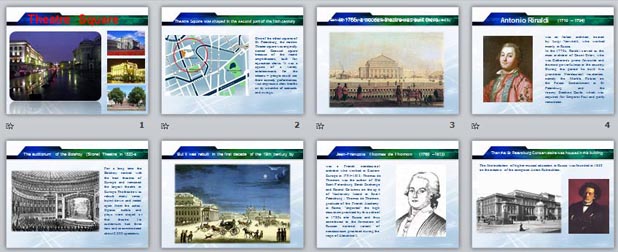
Theatre Square

Theatre Square was shaped in the second part of the 18th century
One of the oldest squares of St. Petersburg, the modern Theater square was originally named Carousel square because of the round amphitheaters, built for equestrian shows. It was a square of a variety entertainments for the citizens – people could see there comedy performances, visit impressive show booths or try a number of carousels and swings.

In 1765, a wooden theatre was built there.
Between 1775 and 1783, the Bolshoy or Stone Theatre was erected by

Antonio Rinaldi
(1710 – 1794)
was an Italian architect, trained by Luigi Vanvitelli, who worked mainly in Russia.
In the 1770s, Rinaldi served as the main architect of Count Orlov, who was Catherine's prime favourite and the most powerful man in the country. During this period he built two grandiose Neoclassical residences, namely the Marble Palace on the Palace Embankment in St Petersburg and the roomy Gatchina Castle, which was acquired for Emperor Paul and partly remodeled.

The auditorium of the Bolshoy (Stone) Theatre in 1820-s
For a long time the Bolshoy ranked with the best theatres of Europe and remained the largest theatre in Europe. The theatre was rebuilt many times, burnt down and rected again from the ashes. Operas, ballets and plays were staged at that theatre. Its auditorium had three tiers and accommodated about 2,000 spectators.

But it was rebuilt in the first decade of the 19th century by

(1760 –1813)
Jean-François Thomas de Thomon
was a French neoclassical architect who worked in Eastern Europe in 1791–1813. Thomas de Thomon was the author of Old Saint Petersburg Stock Exchange and Rostral Columns on the spit of Vasilievsky Island in Saint Petersburg . Thomas de Thomon, graduate of the French Academy in Rome, "imported" the high classicism practiced by this school in 1780s into Russia and thus contributed to the formation of Russian national variant of neoclassicism practiced during the reign of Alexander I.

Then the St Petersburg Conservatoire was housed in this building
The first institution of higher musical education in Russia was founded in 1862 on the initiative of the composer Anton Rubinshtein.

The famous graduates of the Conservatoire
Pyotr Tchaikovsky
Sergey Prokofyev
Dmitry Shostakovich

(1844 - 1908)
Nikolay Rimsky-Korsakov
In 1944, the Conservatoire was named after the great Russian composer Nikolay Rimsky-Korsakov.

Next to the Conservatoire there are two monuments to two outstanding Russian composers
The monument to N. Rimsky-Korsakov was designed by sculptors Veniamin Bogolyubov and Victor Ingal and erected in 1952.
The monument to Mikhail Glinka is the creation of the sculptor Robert Bakh. It was mounted in 1906.

Opposite the Conservatoire stands the Mariinsky Theatre.

The architects of the Mariinsky Theatre
After the fire of 1859, the building was reconstructed according to the design of the architect Albert Kavos. The appearance of the building, its main facade is a result of the reconstruction undertaken between 1894 and 1895 under the supervision of the architect Victor Schroter.

Maria Alexandrovna
The new theatre was named the Mariinsky Theatre after Maria Alexandrovna, the wife of Alexander II.

The theatre was inaugurated on the 2nd of October, 1860 with the opera “Life for the Tsar” (“Ivan Susanin”) by Mikhail Glinka.

Famous performers of Mariinsky Theatre
Tamara Karsavina
Leonid Sobinov
Fyodor Shaliapin
Anna Pavlova

Famous performers of Mariinsky Theatre
Mathilda Kshesinskaya
Galina Ulanova
Vaslav Nizhinsky
Mikhail Fokin

For several years the ballet company was headed by Maurice Petipa.

The Mariinsky Theatre is famous all over the world by its preserved traditions of Russian classic ballet.

Thanks for your attention
Автор презентации:
Учитель английского языка
ГБОУ СОШ № 180
Санкт-Петербург
Дмитрук Л.Е.
View of the Square and the Grand Theatre, St Petersburg

Интернет - ресурсы

Интернет - ресурсы


 Получите свидетельство
Получите свидетельство Вход
Вход


































 Театральная площадь (английский язык) (2.43 MB)
Театральная площадь (английский язык) (2.43 MB)
 0
0 454
454 7
7 Нравится
0
Нравится
0


